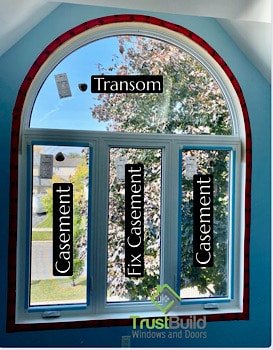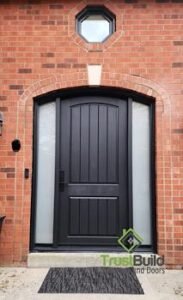Advantages and Disadvantages of Casement Windows: What You Need to Know
Casement windows are among the most efficient window systems available, offering excellent ventilation, security, and ease of maintenance. They provide a strong seal when closed, making them highly energy-efficient. However, like any window style, they also have some limitations. In this guide, we’ll explore the pros and cons of casement windows to help you decide if they are the right choice for your home.
Advantages of Casement Windows
- Superior Ventilation and Airflow: Casement windows open fully outward, allowing maximum fresh air circulation. Unlike sliding or double-hung windows, which have only partial openings, casement windows capture and direct breezes into your home, improving natural ventilation.
- Excellent Energy Efficiency: One of the biggest benefits of casement windows is their airtight seal. When closed, the operational sash presses firmly against the frame, preventing air leaks. The wind naturally pushes the sash tighter against the frame, enhancing insulation and reducing energy loss.
- Multi-Point Locking System for Enhanced Security: Casement windows feature a multi-point locking system, which secures the window at multiple points along the frame. This design significantly improves home security, as it makes the window much harder to pry open compared to traditional sliding or single-hung windows.
- Unobstructed Views and Natural Light: Since casement windows typically have a single large sash without multiple muntins or grids, they offer clear, unobstructed views and allow more natural light to enter the room.
- Easy Cleaning and Maintenance: Casement windows are designed to be cleaned easily from the inside, making them an excellent choice for second-story rooms or hard-to-reach areas. With a simple crank mechanism, the exterior glass can be accessed without the need for ladders.
Disadvantages of Casement Windows
- Limited Design Options for Certain Window Shapes: One of the few drawbacks of casement windows is their incompatibility with round or arched window openings. If you have a rounded window space, a transom (a separate fixed window) must be added above the casement window, which could slightly alter the overall aesthetic.
- Potential Wear and Tear on Hardware: Casement windows rely on a crank mechanism for operation. Over time, the crank system and hinges may experience wear and require maintenance or replacement.
- Space Considerations When Opening: Since casement windows open outward, they require enough clearance outside. This can be a concern if they are installed near walkways, decks, or other structures where an outward-opening window could obstruct movement.
Final Thoughts
Casement windows are an excellent choice for homeowners seeking energy efficiency, superior ventilation, and enhanced security. While they have a few minor drawbacks, such as compatibility with rounded window openings and potential crank mechanism maintenance, their advantages far outweigh their disadvantages.
Fixed Casement Windows: Features, Benefits, and Differences from Picture Windows
Fixed casement windows combine the aesthetics of traditional casement windows with the practicality of a non-operable design. They are designed to match functional casement windows, creating a seamless look in a home’s exterior. In this guide, we’ll explore the purpose, benefits, and key differences between fixed casement windows and picture windows.
What Is a Fixed Casement Window?
A fixed casement window is a non-operable window that maintains the profile and design of a standard casement window. The primary purpose of a fixed casement is to complement operable casement windows, ensuring a uniform appearance throughout a home’s façade.
Benefits of Fixed Casement Windows
- Enhanced Aesthetic Consistency: Fixed casement windows are designed to look identical to regular casement windows. When used in combination, they create a balanced, cohesive exterior without visual differences between operable and non-operable windows.
- Increased Structural Support for Large Openings: For larger window openings, a wider fixed casement frame adds extra support and stability. This ensures durability and enhances security, making it a strong choice for expansive window designs.
- No Need for a Window Transom: One key advantage of fixed casement windows is that, when the window size falls within standard limitations, a transom window is not required. This allows for larger, uninterrupted glass panels, offering improved aesthetics and more natural light.
- Versatile Design Options: Unlike operable casement windows, fixed casement windows can be customized into various shapes, including:
- Octagon
- Fully round
- Oval
Fixed Casement vs. Picture Windows: Key Differences
| Feature | Fixed Casement Window | Picture Window |
|---|---|---|
| Frame Profile | Matches standard casement window frames | Slimmer frame for a sleeker appearance |
| Glass Area | Slightly less glass due to thicker frame | More glazing with minimal framing |
| Support & Security | Provides additional structural support | More emphasis on aesthetics and open views |
| Transom Requirement | Often eliminates the need for a transom window | Also reduces the need for a transom if within size limits |
Conclusion
Fixed casement windows offer the perfect balance between style and function, ensuring visual consistency while adding structural strength. When comparing them to picture windows, the choice depends on whether you prioritize a uniform design with other casement windows (fixed casement) or a minimalist look with maximum glass area (picture window).
Whether you’re designing a modern home or looking for large, stylish window solutions, fixed casement and picture windows provide excellent options with unique advantages.
Transom Windows: Purpose, Benefits, and When to Use Them
A transom window is a fixed window or a combination of fixed windows installed above another window or window system. These windows are commonly used when the overall window opening height exceeds the maximum height of an operable window. In this guide, we’ll explore what transom windows are, why they are used, and how they enhance both aesthetics and functionality.
What Is a Transom Window?
A transom window is a non-operable window positioned above a primary window or door. Its purpose is to extend the height of a window system while maintaining a seamless and stylish look.
When Is a Transom Window Needed?
Transom windows are necessary when a window opening is too tall for a single operable window. For example:
- If the window opening is 120 inches tall, but the maximum casement window height is 72 inches, a transom window is installed above to fill the remaining space while maintaining a cohesive appearance.
Benefits of Transom Windows
- Allows for Larger Window Designs: Transom windows help accommodate extra-tall window openings, making it possible to install expansive glass panels while ensuring proper structural support.
- Enhances Natural Light: Since transom windows are fixed and often located higher on the wall, they allow additional natural light to enter the room without compromising privacy.
- Creates a More Elegant and Custom Look: Adding a transom window gives windows a more sophisticated and architecturally appealing appearance, making them a popular choice for modern and traditional homes alike.
- Improves Aesthetic Continuity: Transom windows blend seamlessly with casement, fixed casement, or picture windows, ensuring a balanced and visually cohesive design.
Conclusion
Transom windows are a practical and stylish solution for tall window openings, ensuring a perfect balance between design, functionality, and natural light. Whether you’re working with casement windows or other window systems, a transom window allows for larger, elegant, and well-lit spaces without sacrificing efficiency.







